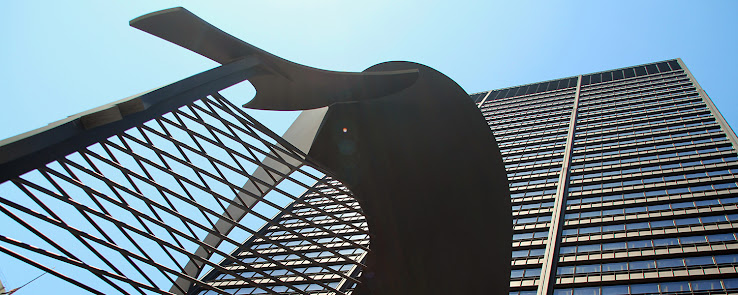

Union Stock Yard Gate..
Address: Exchange Ave. at Peoria St.
Year Built: 1875
Architect: Burnham & Root
Date Designated a Chicago Landmark: February 24, 1972..
Added to the National Register of Historic Places: December 27, 1972..
Designated a National Historic Landmark: May 29, 1981..

The marker reads..
Chicago Landmark..
Union Stock Yard Gate
Burnham and Root, architects
Yard open 1865-1972..
At one time sprawling over 475 acres, the Union Stock Yards thrived for a century, until its closing in 1971. This rugged limestone gate, which marked the entrance to the stockyards, survives as one of the few visual reminders of Chicago's past supremacy in the livestock and meatpacking industries.
Designated a Chicago Landmark on Feburary 26, 1972
by the City Council of Chicago
Richard J. Daley, Mayor
Commission on Chicago Historical and Architectural Landmarks..


The limestone steer head over the central arch is traditionally thought to represent "Sherman," a prize-winning bull named after John B. Sherman, one of the founders of the Union Stock Yard and Transit Company. Through the arch once passed the people and livestock that made Chicago the "hog butcher to the world".

The stockyards opened in 1865 and made Chicago the center of the American meat packing industry for decades. Using Chicago as a hub, this new stockyard served as a commercial link between America's East and West. Fifteen miles of track delivered livestock directly to the stockyards from the city's main rail lines. In addition, hedging transactions by the stockyard companies played a key role in the establishment and growth of the Chicago-based commodity exchanges and futures markets.
The working conditions for the thousands employed at the Union Stock Yards were terrible. Laborers on the killing floors had to work amidst the stench and piercing shrieks of animals being slaughtered while standing on blood-soaked floors. They worked long hours-usually ten to twelve a day-in temperatures exceeding 100 degrees in the summertime. Stockyard employers could keep wages low and withhold benefits due to the ready supply of immigrant workers desperate to earn a living. Upton Sinclair’s novel, The Jungle, describes the life of a family of immigrants working in Chicago's Union Stock Yards at the end of the 19th century..


No comments:
Post a Comment